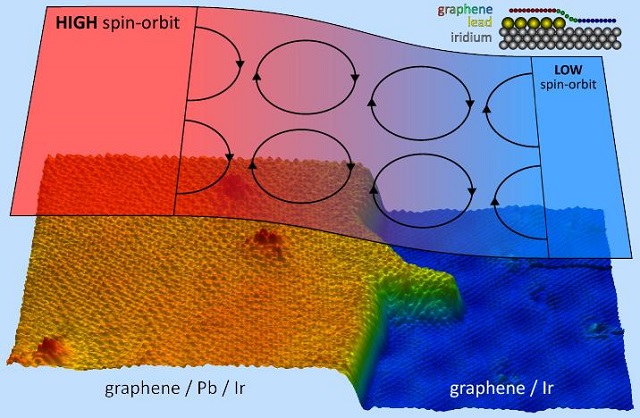 In the sea of graphene (over an iridium crystal), electrons' spin-orbit interaction is much lower than that created by intercalating a lead island. Credit: IMDEA Nanoscience/UAM/ICMM-CSIC/UPV-EHU
In the sea of graphene (over an iridium crystal), electrons' spin-orbit interaction is much lower than that created by intercalating a lead island. Credit: IMDEA Nanoscience/UAM/ICMM-CSIC/UPV-EHU
A team of researchers in Spain have developed a method to generate a powerful magnetic field by intercalating lead atoms on a graphene sheet. The team included researchers from IMDEA Nanoscience, the University of the Basque Country, the Madrid Institute of Materials Science (CSIC) and the Autonomous University of Madrid.
Graphene conducts electrons very rapidly and hence has amazing electronic, mechanical and optical properties. However, graphene does not possess magnetic properties. This has prevented researchers from finding out methods to manipulate its electrons, or their properties, which would enable it to be used for magnetoelectronic device applications. The researchers in Spain have found that when they intercalated lead atoms on a graphene sheet, a powerful magnetic field was generated due to the interaction between the spin of electrons and their orbital movement. The European Union is promoting emerging spintronics technology for creating sophisticated computational systems.
The secret discovered by the research team was to intercalate Pb islands or atoms below the hexagons of carbon that comprise the sea of graphene. This leads to a massive interaction between two paeameters characterizing the electrons - the spin and the orbit. The orbit of an electron is its movement around the nucleus, and the spin is a small 'magnet' that is linked to electron rotation.
This spin-orbit interaction is a million times more intense than that inherent to graphene, which is why we obtain revolutions that could have important uses, for example in data storage.
Rodolfo Miranda, Director of IMDEA Nanoscience and head of the study
In order to achieve this effect, the researchers grew a layer of graphene over an iridium crystal. Then they laid a layer of lead over the graphene layer. This led to the formation of 'islands' below the sea of graphene material. Graphene’s electrons behave as if under the presence of an enormous 80T magnetic field and this allowed specific control of spin flow.
And, what is most important, under these conditions certain electronic states are topologically protected; in other words, they are immune to defects, impurities or geometric disturbances. If we compare it to traffic, in a traditional spintronic material cars circulate along a single-lane road, which make collisions more likely, whilst with this new material we have traffic control with two spatially separate lanes, preventing crashes.
Giant magnetoresistance was discovered by Albert Fert and Peter Grünberg, for which they were awarded the Nobel Prize in Physics in 2007. Spintronics arose with this discovery. It is a novel technology that utilizes the magnetic spin of electrons to store bits of information. The spintronics effect creates large changes to the electric resistance of multi-layer materials. This has helped develop a variety of components including hard disk reader heads and airbag sensors.
The magnetoresistant or spintronic devices that were initially built were based on the effect that magnetic materials had on electron spin. This was the first generation of devices. The second generation of devices is already in use. In these devices, the spin-orbit interaction of the electrons acts like a real external magnetic field, even when such as field does not exist.
The 'Graphene Flagship' project of the European Union aims to use graphene in spintronics applications as an active component. The team of researchers aims to achieve willful control of the type of electron spin in the novel material so as to apply it for future electronic devices.
This study titled "Spatial variation of a giant spin-orbit effect induces electron confinement in graphene on Pb islands" has been published in the journal Nature Physics.
References